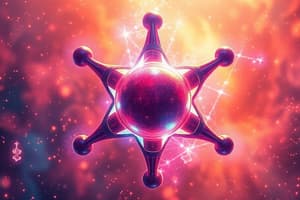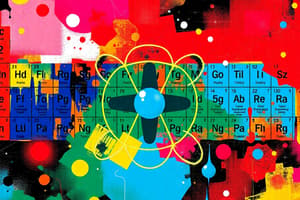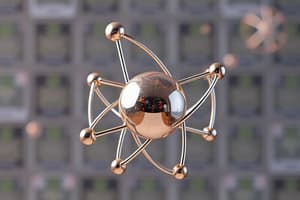Podcast
Questions and Answers
What is the primary function of ribosomes in a cell?
What is the primary function of ribosomes in a cell?
- To protect the cell membrane
- To store materials
- To assemble proteins (correct)
- To produce lipids
Which statement accurately describes multicellular organisms?
Which statement accurately describes multicellular organisms?
- They consist of one cell that performs all functions independently.
- They contain specialized cells that rely on each other for survival. (correct)
- They have no specialized cells.
- They can only survive in extreme environments.
What is the role of vacuoles in a cell?
What is the role of vacuoles in a cell?
- To control nutrient absorption
- To break down waste materials
- To store various materials (correct)
- To provide structural support
How do specialized cells function when grouped together?
How do specialized cells function when grouped together?
What does the cell wall do?
What does the cell wall do?
What is the atomic mass of Carbon?
What is the atomic mass of Carbon?
Which of the following is NOT a property of metals?
Which of the following is NOT a property of metals?
In which state of matter are most metals at room temperature?
In which state of matter are most metals at room temperature?
What structure is formed by metallic bonding?
What structure is formed by metallic bonding?
Which organelle is responsible for producing chemical energy in animal cells?
Which organelle is responsible for producing chemical energy in animal cells?
What determines the group in the periodic table?
What determines the group in the periodic table?
Which of the following is a property of nonmetals?
Which of the following is a property of nonmetals?
What is the primary function of vacuoles in plant cells?
What is the primary function of vacuoles in plant cells?
How are neutrons in an element determined?
How are neutrons in an element determined?
Which type of endoplasmic reticulum is involved in lipid production?
Which type of endoplasmic reticulum is involved in lipid production?
Which group is known as Noble Gases?
Which group is known as Noble Gases?
Which layer serves as the outermost barrier in plant cells?
Which layer serves as the outermost barrier in plant cells?
Which element group does not include metals?
Which element group does not include metals?
What type of cells have large vacuoles for storage?
What type of cells have large vacuoles for storage?
What substance fills the inside of a cell and holds organelles in place?
What substance fills the inside of a cell and holds organelles in place?
Which of the following is not a function of lysosomes?
Which of the following is not a function of lysosomes?
Flashcards
Metallic Bonding
Metallic Bonding
The bonding in metals where valence electrons are delocalized, forming a "sea of electrons" that surrounds positively charged metal ions in a lattice structure.
Valence Electrons
Valence Electrons
Electrons in the outermost shell of an atom, involved in chemical bonding.
Atomic Number
Atomic Number
The number of protons in an atom's nucleus, which also equals the number of electrons.
Electron Shells
Electron Shells
Signup and view all the flashcards
Groups (Periodic Table)
Groups (Periodic Table)
Signup and view all the flashcards
Periods (Periodic Table)
Periods (Periodic Table)
Signup and view all the flashcards
Metal Properties
Metal Properties
Signup and view all the flashcards
Nonmetal Properties
Nonmetal Properties
Signup and view all the flashcards
RER
RER
Signup and view all the flashcards
SER
SER
Signup and view all the flashcards
What are the specialized functions of cells called?
What are the specialized functions of cells called?
Signup and view all the flashcards
Unicellular vs. Multicellular
Unicellular vs. Multicellular
Signup and view all the flashcards
What is the role of a cell wall?
What is the role of a cell wall?
Signup and view all the flashcards
What is a cell?
What is a cell?
Signup and view all the flashcards
What's the function of the nucleus?
What's the function of the nucleus?
Signup and view all the flashcards
What do mitochondria do?
What do mitochondria do?
Signup and view all the flashcards
What is cytoplasm?
What is cytoplasm?
Signup and view all the flashcards
What makes plant cells different?
What makes plant cells different?
Signup and view all the flashcards
What does the cell membrane do?
What does the cell membrane do?
Signup and view all the flashcards
What does the endoplasmic reticulum do?
What does the endoplasmic reticulum do?
Signup and view all the flashcards
What are lysosomes?
What are lysosomes?
Signup and view all the flashcards
Study Notes
Chemistry
- Lattice Structure: Atoms are arranged in a repeating pattern. Positive and negative ions are arranged in a repeating pattern. Delocalized electrons surround the metal ions.
- Groups and Periods: Groups are vertical columns on the periodic table; elements in the same group have the same number of valence electrons. Periods are horizontal rows; elements in the same period have the same number of electron shells.
- Atomic Structure of Carbon: Carbon has 6 protons, 6 neutrons, and 6 electrons. Its atomic mass is 12.01. Protons and neutrons are in the nucleus; electrons orbit the nucleus.
- Metals, Nonmetals, and Metalloids: Metals are lustrous (shiny), malleable (can be hammered into thin sheets), ductile (can be stretched), and good conductors of electricity and heat (generally in a lattice structure).
- Properties of metals: Lustrous, malleable, ductile, good conductors of heat and electricity (generally in a lattice structure). Solid at room temperature except for Mercury.
- Properties of Nonmetals: Bad conductors (with the exception of graphite), brittle, generally less dense than metals, low melting and boiling points, dull.
- Properties of Metalloids: Metallic luster, brittle, solid at room temperature, ok conductivity, meaning they can conduct electricity and heat but not as well as metals.
- Metallic Bonding: Metal atoms are packed in a lattice structure. Outermost electrons (valence electrons) are delocalized (move freely), forming a "sea of electrons" that surrounds positively charged metal ions. This unique structure gives the metals their characteristic properties.
Biology
Microscopes
- Microscope Parts: Microscopes have components like stage, lenses, focus controls, base, arm, and light source.
- Magnification: Optical lenses typically have a 10x magnification.
Cells and Organelles
- Cells: Basic units of all living things.
- Animal Cells: Have a nucleus (stores genetic information), mitochondria (produces chemical energy), ribosomes (assemble proteins), cytoplasm (jelly-like substance holding organelles), endoplasmic reticulum (RER - produces proteins, SER - produces lipids), vacuoles (store materials), and lysosomes (break down materials).
- Plant Cells: Have a nucleus, mitochondria, ribosomes, cytoplasm, endoplasmic reticulum, large vacuoles, and a cell wall (outermost layer which provides support, and acts as a rigid barrier), cell membrane (second outermost layer that controls what comes into and out of the cell).
- Cell Functions: Specific organelles perform different roles in cell function.
Fungal Cells
- Fungal Cells: Similar to plant cells in terms of structures like nucleus, mitochondria, endoplasmic reticulum, vacuoles, ribosomes, and cytoplasm. Differ with cell wall characteristics and roles.
- Cell Wall (Outermost layer which provides support, and acts as a rigid barrier).
Multicellular vs. Unicellular Organisms
- Multicellular Organisms: Composed of multiple cells, with cells often specialized. They rely on each other for survival and tasks.
- Unicellular Organisms: Consist of single cells, performing all necessary functions of life independently.
Specialized Cells
- Specialised Cells: Muscle cells (for contraction), nerve cells (transmitting signals), blood cells (carrying oxygen and fighting infections), fat cells (energy storage), and root hair cells (absorption of water and nutrients from the ground). Each specialized cell has a unique structure to enable it to perform its specialized function.
Studying That Suits You
Use AI to generate personalized quizzes and flashcards to suit your learning preferences.
Related Documents
Description
Explore the fundamental concepts of atomic structure, lattice formation, and the classification of elements in this chemistry chapter. Understand how atoms are organized in groups and periods on the periodic table, along with the unique properties of metals, nonmetals, and metalloids. Test your knowledge about the atomic structure of carbon and the arrangement of ions.




